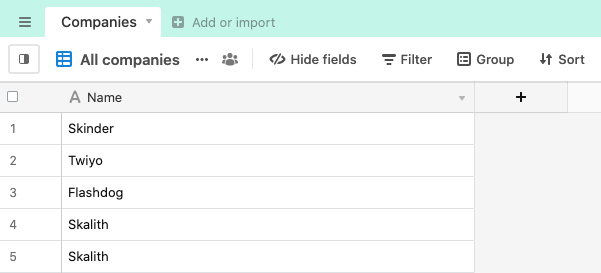Finding unique records
Setting the scene: We have a set of records - in this case, company names - and we want to weed out the duplicates and find a unique set of names (by implication, we’re going to end up with the “first” occurrence of any company name and discard second and subsequent occurrences). Our data looks like this:

Here’s our script:
let companiesT = base.getTable('Companies');
let companiesQ = await companiesT.selectRecordsAsync();
const records = companiesQ.records
const seen = new Set();
const filteredArr = records.filter(el => {
const duplicate = seen.has(el.getCellValue('Name'));
seen.add(el.getCellValue('Name'));
return !duplicate;
});
output.table(filteredArr)
Let’s walk though this line by line to explain what is going on. The first 3 lines set up our table, a query and we assign the query records to the variable records:
let companiesT = base.getTable('Companies');
let companiesQ = await companiesT.selectRecordsAsync();
const records = companiesQ.records
The next line creates a new Set:
const seen = new Set();
A Set is an object that stores unique values and a value in a Set can only occur once.
Next, we’re going to filter the records returned by the query from our table. Here’s the code:
// set up the resulting filtered array using records.filter
const filteredArr = records.filter(el => {
// use the `has` method on the Set to check if the
// current record's Name value is in the array
// `seen.has` returns true or false, so the variable duplicate will be true or false
const duplicate = seen.has(el.getCellValue('Name'));
// Add the current Name value to the set
// If the value is already in the Set
// then it won't be created a second time
seen.add(el.getCellValue('Name'));
// return the opposite duplicate
return !duplicate;
});
The last part of this filter is where the magic happens! If duplicate is true (so we’ve seen the Name value before), then return the opposite of duplicate, so in this case false. Returning false excludes the current record from the final filtered array. Conversely, is duplicate is false (so we haven’t seen this Name value before), then return true. Returning true includes the current record in the filtered array.
Finally, we output the filtered array to view using output.table.
From here we can use the filtered array to mark these records as the originals or mark anything not in this array as a duplicate.